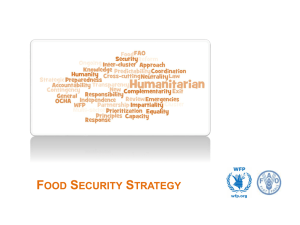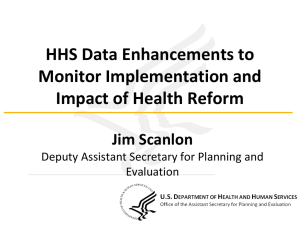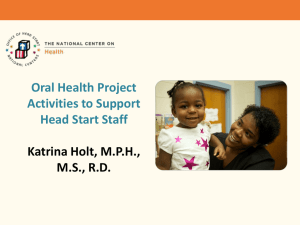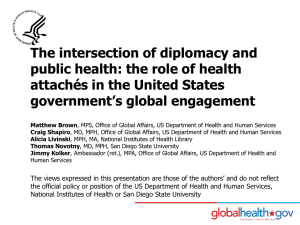Presentation - PHS Commissioned Officers Foundation for the
advertisement
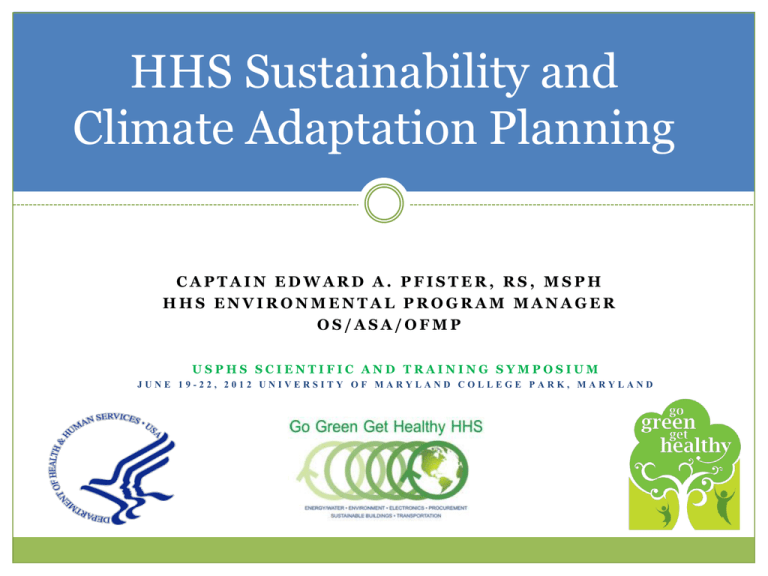
HHS Sustainability and Climate Adaptation Planning CAPTAIN EDWARD A. PFISTER, RS, MSPH HHS ENVIRONMENTAL PROGRAM MANAGER OS/ASA/OFMP USPHS SCIENTIFIC AND TRAINING SYMPOSIUM JUNE 19-22, 2012 UNIVERSITY OF MARYLAND COLLEGE PARK, MARYLAND Introduction Severn Cullis-Suzuki, started the Environmental Children’s Organization (ECO) when she was 9-years-old At 12-years-old she closed a Plenary Session at the Earth Summit in Rio de Janeiro with a speech, the video is now known as the "The Girl Who Silenced the World for 6 Minutes“ http://www.youtube.com/watch?feature=player_embedded &v=5g8cmWZOX8Q 2 THREE THINGS + 1 1. HHS Strategic Sustainability Performance Plan (SSPP) 2. HHS Climate Change Adaptation Plan (Draft) 3. HHS Environmental Justice Strategy 4. Go Green Get Healthy HHS Initiative 3 Part I: HHS Strategic Sustainability Implementation Plan (SSPP) Executive Order 13514 Strategic Sustainability Performance Plan (SSPP) – 2012 is going through the Departmental review process Climate Change Adaptation Plan – new for 2012 and will be out soon through the Departmental review process Oversight by White House Council on Environmental Quality (CEQ) and Office of Management and Budget (OMB) Publicly available http://www.whitehouse.gov/administration/eop/ceq/sustainability /plans 4 HHS Mission Connection to HHS Mission “To enhance the health and well-being of Americans by providing for effective health and human services and by fostering sound, sustained advances in the sciences underlying medicine, public health, and social services.” Sustainability “Enduring prosperity of all living things” – American Institute of Architects (AIA) Committee on the Environment “…to create and maintain conditions, under which humans and nature can exist in productive harmony, that permit fulfilling the social, economic, and other requirements of present and future generations;” Executive Order 13514 5 HHS Impact • • • • • • • • Employees ~ 83,000 Buildings ~ 3,800 Vehicles ~591 Owned, 2,150 Leased Square Feet (gsf) ~52 M • Owned/Operated ~ 32 M • Leased ~ 20 M • Labs ~ 18M gsf (~277 Bldgs) Operating Budget ~ $854 Billion Energy Cost (owned) > $ 50 M Solid Waste ~ 50K Mtons Recycling Rate ~ 23% HHS EMPLOYEES BY OPDIV/STAFFDIV Source: OPM Dec 2010 Data CDC 12% IHS 16% FDA 18% OS & NonLand holders 31% NIH 23% 6 Key Players 2012 HHS SSPP 1. Chief Sustainability Officer (ASA) 2. Sustainability Steering Committee (OPDIV Senior Level Leadership) 2. Sustainability Task Force (OPDIV Sustainability Officers, SMEs, responsible offices) 3. Eleven working groups aligned with goals (OS lead with OPDIVs representatives) 4. OPDIV Sustainability Officers (sits on task force & leads OPDIV workgroup representatives) 7 HHS Strategic Sustainability Performance Plan – GOALS/WORKGROUPs 8 1. Scope 1 & 2 Greenhouse Gas 6. Reduce Potable Water Reduction Intensity 2. Scope 3 Greenhouse Gas Reduction 7. Pollution Prevention/Waste Reduction 3. Energy Reduction 8. Sustainable Acquisitions 4. Fleet Petroleum Use Reduction 9. Electronic Stewardship & Data Centers 5. Sustainable Design / Green Buildings 10.Innovation 11. Outreach 8 Reduce Emissions: What is a Greenhouse Gas? 9 HHS Performance Metrics (scorecard) Scope 1&2 GHG Emission Reduction Target: GREEN - On track for a Scope 1&2 GHG Reduction Target of 10.3% by 2020. (8.7% FY11) Reduction in Energy Intensity: GREEN - Reduced energy intensity by at least 15 percent and is on track for 30 percent reduction by 2015. (19% FY11) Use of Renewable Energy GREEN – Acquire 5 percent electricity from renewable sources and on track to increase to 7.5% by 2015. Reduction in Fleet Petroleum Use: GREEN - 20 % reduction by 2015. (27% FY11) Reduction in Potable Water Intensity: YELLOW - Reduce by at least 8 and on track to achieve 26% by 2020. (7% Fy11) Green Buildings: RED - Less than 7 % of building inventory, either by number or buildings or GSF, over 5,000 GSF meets Federal Guiding Principles. (4% FY11) 10 Sustainability: Opportunities for Department Wide Integration Affordable Care Act ATSDR implemented Community Assistance Panels CDC Health Impact Assessment Communities Deepwater Horizon/Gulf Coast Recovery Environmental Justice Implementation Strategy HHS Environmental and National Environmental Policy Act (NEPA) programs HHS Climate Change Adaptation Plan - DRAFT Healthy People 2020 HRSA Community and Rural Health Grants Let’s Move National Health Security Strategy National Prevention Strategy NIEHS Minority Worker Training Programs “Every American deserves to have a clean, safe and healthy environment. Today, we understand better than ever before that our health is not only dependent on what happens in the doctor’s office but is determined by the air we breathe, the water we drink and the communities we call home” HHS EJ Strategy http://www.hhs.gov/environmentaljustice/st rategy.html 11 PART II: Climate Change Adaptation Plan Executive Order (E.O.) 13514, “Federal Leadership in Environmental, Energy, and Economic Performance,” requires that each Federal agency evaluate agency climate change risks and vulnerabilities to manage both the short and longterm effects of climate change on the agency’s mission and operations, and prepare a Climate Change Adaptation Plan (Adaptation Plan). 12 Climate Change Preliminary Vulnerability Analyses Protecting the most vulnerable: ensure essential health and human services in the face of weather extremes and climate threats Office on Disability Administration on Community Living/Administration for Children and Families Administration on Aging Center for Medicare & Medicaid Services Indian Health Service Assistant Secretary for Preparedness and Response Incorporating Climate Change Considerations into Regulatory Decisions FDA Incorporating Climate Change Considerations into Public Health Practice and Research CDC, ATSDR, NIH 13 Climate Change Premises Warming of the climate systems is clear and unmistakable - Polar regions are warming more rapidly than the rest of the earth Human activity adds GHG to the atmosphere and is likely responsible for a good part of observed climate change impacts Climate changes are occurring and expected to continue and increase Stresses to water resources, energy, agriculture Increased risk of sea level flooding in coastal areas Threatened ecosystems 14 Climate Change: Adaptation and Mitigation Adaptation is a response, the actions necessitated by the actual or anticipated impacts of climate change. Mitigation is the effort to stop or slow climate change, usually by reducing the GHG emissions driving the problem. Two prongs used in concert: mitigation reduces impacts, making adaptation easier . 15 “A number of scientific panels, including the U.S. Global Change Research Program, and International Panel on Climate Change, have published data indicating that climate change is already negatively affecting human health in the United States, and is likely to continue impacting human health in the future.” 16 Interagency Climate Change Report 17 “Climate change will endanger public health, affecting all sectors of society, both domestically and globally.” - Executive Summary, Report of the Interagency Working Group on Climate Change and Health., Published 2010 A Human Health Perspective on Climate Change: http://www.niehs.nih.gov/health/docs/climatereport2010.pdf 17 Potential Health Effects of Climate Change HEAT SEVERE WEATHER Climate Change Temperature rise Sea level rise Hydrologic extremes Adapted from J. Patz AIR POLLUTION ALLERGIES VECTOR-BORNE DISEASES WATER-BORNE DISEASES WATER AND FOOD SUPPLY Heat stress, cardiovascular failure Injuries, fatalities Asthma, cardiovascular disease Respiratory allergies, poison ivy Malaria, dengue, encephalitis, hantavirus, Rift Valley fever Cholera, cryptosporidiosis, campylobacter, leptospirosis Malnutrition, diarrhea, harmful algal blooms Anxiety, despair, depression, MENTAL HEALTH post-traumatic stress ENVIRONMENTAL REFUGEES Forced migration, civil conflict18 Key elements of the HHS approach to incorporating climate change adaptation Integrating climate change and environmental impact considerations into internal management functions and policies Collecting, analyzing, and utilizing state of the science data Enhancing issue awareness and specialty training for our employees and the public Leveraging HHS regional and preparedness programs and existing healthy community and climate change initiatives Enhancing collaboration with other federal agencies, State, Local, and Tribal governments 19 Key Messages for Climate Change and Human Health Changes occurring in the world’s climate are affecting our health and will have even greater impacts in the future. Climate change makes many existing diseases and conditions worse, although it may also lessen some cold-weather diseases. The most vulnerable among us—children, elderly people, those living in poverty, with underlying health conditions, or in certain geographic areas— are likely to have less ability to cope or adapt. Climate change places stress on our health care systems, public health infrastructure, and ability to deliver and receive health services. We can take steps now to prepare for changes in our climate that will protect our health, the health of our children, and that of future generations. Many actions to address and prepare for climate change will yield co- benefits for our health, our environment, our economy, and our society. HHS Climate Change Adaptation Portfolio “Public Health Effects of Climate Change Remain Largely Unaddressed.” Howard K. Koh, Assistant Secretary for Health • CDC Ready States and Cities Initiative (8 states/2 cities) – assessments, strategic plans, partnerships, co-benefits… • NIH Population Vulnerability to Climate Change Grants.: research on the health effects of air pollution and temperature, water quality and quantity, infectious disease transmission, and mitigation/adaptation actions • The Substance Abuse and Mental Health Services Administration (SAMHSA) and Assistant Secretary for Preparedness and Response (ASPR) partnering on behavioral health needs during disasters and public health emergencies. • CDC and NIEHS leadership on the Climate Change and Human Health Group, US Global Research Program 21 Co-Benefits: Adaptation/Mitigation Ancillary benefits related to reductions in toxic air pollution For example, transportation policies that augment the use of public transportation or provide safer and more convenient means for individuals to walk or bicycle Co-benefits: •reductions in toxic air pollution •Increases in physical activity 22 Co-Benefits: Adaptation/Mitigation 23 Measures needed to improve health resilience for climate change effects are the same as those needed for preparedness for bioterrorism, pandemic influenza and other viral infections, and natural disasters. Examples: improved modeling and assessment capacity, enhanced and integrated monitoring and surveillance networks, and development of rapid response units. Addition to assisting in adaptation to changes in climate to which the planet is already committed, public health has crucial roles to play in preventing the more severe impacts of climate change and optimizing the policy measures implemented to reduce greenhouse gas emissions Research need: Greater understanding of the potential for such synergies between climate and public health goals is critically needed. PART III: 2012 Environmental Justice Strategy n Released February 28, 2012 (reinvigoration of 1995 EJ Strategy based on EO Executive Order 12898, Federal Actions to Address Environmental Justice in Minority Populations and Low-Income Populations 1994) Is a significant step in the advancement of HHS’s commitment to integrating EJ into our decision-making and health and human services program activities Our vision is: “A nation that equitably promotes healthy community environments and protects the health of all people.” HHS EJ Website: www.hhs.gov/environmentaljustice 24 EJ Strategic Elements and Crosscutting Actions Four Strategic Elements Subcommittees Policy Development and Dissemination Education and Training Research and Data Collection, Analysis, and Utilization Services • • • • • • • Seven Cross Cutting Action Teams EJ Award Criteria Vulnerability Assessment and Climate Change Adaptation Strategy Health-In-All-Policies EJ Website EJ Education and Training Community-Based Participatory Research Stakeholder Engagement Group 25 HHS EJ Resources: http://www.hhs.gov/environmentaljustice/ 2012 HHS Environmental Justice Strategy and Implementation Plan 2012 HHS Environmental Justice Implementation Progress Report Environmental Justice sites across HHS CDC/OMHD (http://www.cdc.gov/omhd/amh/EJ.htm) NIH/NIEHS (http://www.niehs.nih.gov/research/supported/programs/justice/ ) NIH/NLM (http://sis.nlm.nih.gov/enviro/environmentaljustice.html) 26 Part IV: Go Green Get Healthy HHS 27 INTRANET – Go Green Get Healthy HHS -Tips on Greening Work and Home -Sustainability Awards and Winners -Sustainability Events Calendar http://intranet.hhs.gov/abouthhs/programs_initiatives/gogreen/index. html Success at the Non-Landholding OPDIVs Examples of Sustainability and Good Business 30 • CMS: Medicare & You •HRSA: IT Asset Donation Handbook Publication Database update Program – responsible end of life disposition of electronic devices • ASFR: upgraded Departmental Contract Information System (DCIS) to track green purchases •ITIO: established Duplex •PSC: Parklawn Building – energy and water savings •SAMHSA: E85 alternative Printing Default Policy fuel/building lighting energy efficient retrofit •OS: Humphrey Café Green • HHS Green Champs Cafeteria Contract 30 HHS Go GREEN Resources HHS Go Green Get Healthy Resources and Green Guide http://intranet.hhs.gov/abouthhs/programs_initiatives/gogreen/ HHS@Work http://intranet.hhs.gov/index.html CDC Sustainability http://www.cdc.gov/sustainability/ IHS http://www.ihs.gov/sustainability/index.cfm?module=dsp_evss_resources NIH http://nems.nih.gov/Sustainability/Pages/sustainability.aspx HHS Green Bag Lunch Presentations http://intranet.hhs.gov/abouthhs/programs_initiatives/gogreen/gbpresentations.html HHS Green Champions 2011 http://intranet.hhs.gov/abouthhs/programs_initiatives/gogreen/2011GreenChampions.html 2010 http://intranet.hhs.gov/abouthhs/programs_initiatives/gogreen/fy2010_champions.html 33 HHS Sustainability Work Group Leaders Workgroup Lead Scope 1 & 2 Greenhouse Gas Reduction Ted Kozak, Theodore.Kozak@hhs.gov Jim Kerr (Fleet) Jim.Kerr@hhs.gov Scope 3 Greenhouse Gas Reduction Jim Egbert james.egbert@hhs.gov Sustainable Design /Green Buildings Regional and Local Planning Jonathan Herz, Jonathan.Herz@hhs.gov Climate Change Adaptation Jonathan Herz, Jonathan.Herz@hhs.gov John Balbus, John.Balbus@nih.gov Water Use Efficiency & Management Ted Kozak, Theodore.Kozak@hhs.gov Pollution Prevention/Waste Reduction Ed Pfister, Edward.Pfister@hhs.gov Sustainable Acquisitions Kesa Russel, Kesa.Russel@hhs.gov Electronic Stewardship & Data Centers Celine Neves, Celine.Neves@hhs.gov Agency Innovation Ed Rau, Ed.Rau@nih.gov Communication/Outreach Paul Kalinowski PaulKalinowski@hhs.gov 34 THREE THINGS + 1 1. HHS Strategic Sustainability Performance Plan (SSPP) 2. HHS Climate Change Adaptation Plan (Draft) 3. HHS Environmental Justice Strategy 4. Go Green Get Healthy HHS Initiative 35 FEEDBACK/DISCUSSION/QUESTIONS Email: GoGreen@hhs.gov 36
